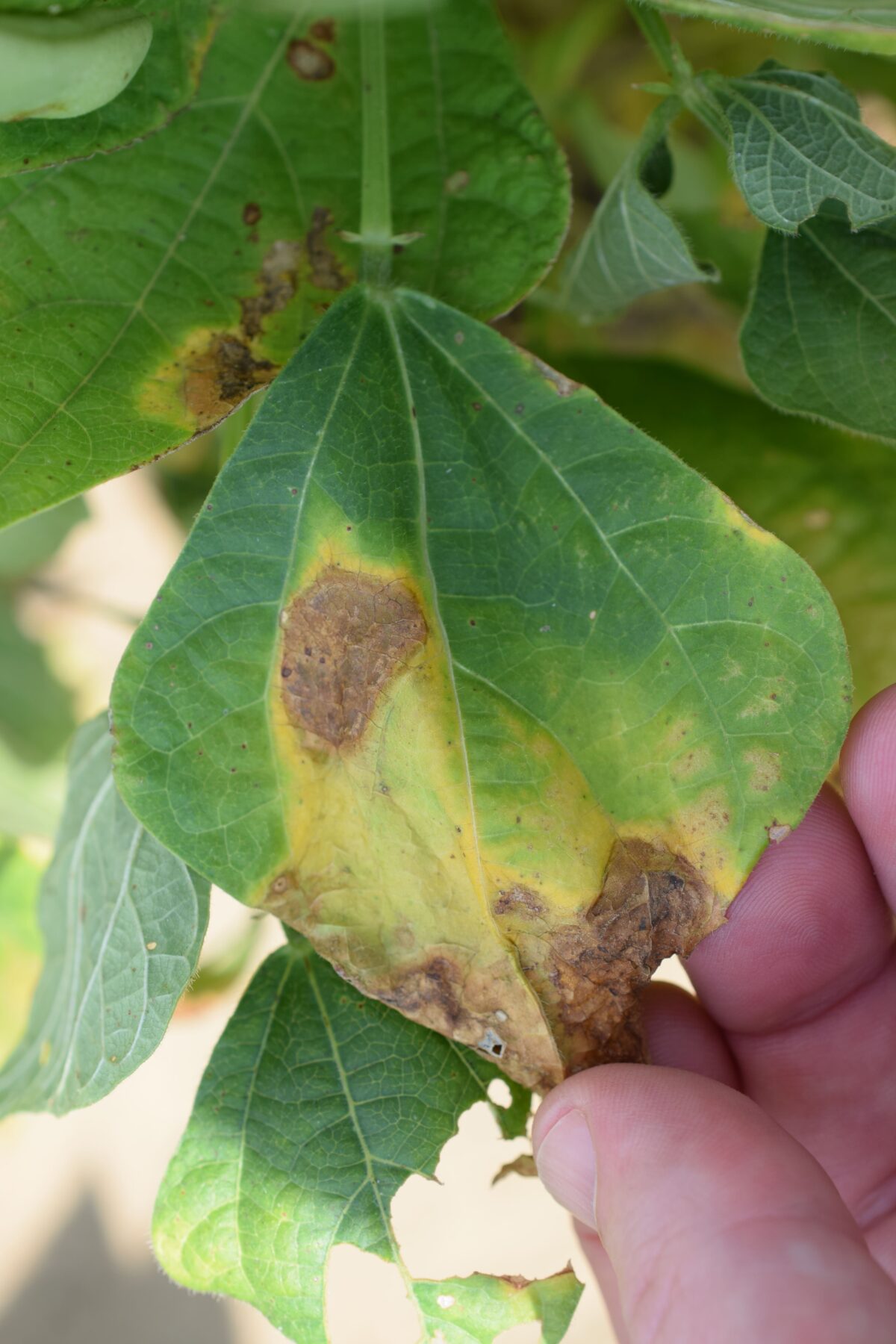There has been a huge amount of focus on dry bean breeding dealing with resistance towards common bacterial blight (CBB) caused by the seed borne bacteria Xanthomonas axonopodis pv. phaseoli (Xap) and X. fuscans pv. fuscans (Xff). This bacterium is controlled through the use of certified seed, however the bacteria can overwinter on crop debris and on certain other legumes. When the bacteria are present, high temperatures and humidity can lead to disease development, even when recommended crop rotations are followed. Thus the use of genetic resistance is recommended. This resistance was developed primarily in navy bean varieties through an interspecies cross with Tepary bean resulting in a source of genetic resistance that has been incorporated into several widely grown navy beans including Rexeter, Lighthouse, Apex and Argosy among others.
Despite the use of disease-free seed and sources of genetic resistance, instances of bacterial blight are continuing to be reported. Several samples of these diseased tissues were processed in our Agriculture and Agri-Food Canada lab in Harrow and they were found to be infested with a different bacterial pathogen. This pathogen was identified through genetic sequencing to be Pseudomonas syringae pv syringae (Pss), which is known to cause Bacterial Brown Spot (BBS) in common bean and other legume relatives. Pss also has more alternative hosts than CBB, such as corn (Holcus blight), wheat and barley (bacterial leaf blight), allowing it to remain in the field and making it more difficult to control.
BBS disease symptoms resemble those of CBB and it can be difficult to differentiate between them unless diagnosed very early in the infection. Both have water-soaked lesions appearing on pods with the CBB lesions being slightly larger. Both have chlorotic or yellow borders around the lesions, which may be less prominent with BBS. The leaves tend to appear more tattered in appearance with BBS infection, with the center of the lesion areas disintegrating and falling out. Both the diseases will cause damage to the pods, with the BBS lesions being slightly smaller and less prominent. The main differences are the pathogens’ preference for weather conditions, with both causing the greatest infections under high moisture and humidity but BBS is more prevalent when temperatures are cooler.
With the similarity of symptoms, we believe that much of the field-based disease screening for CBB is being overstated with many of the symptoms actually being caused by BBS. The actual impact of BBS is underestimated, while CBB is being overestimated. To this end our research group has been investigating the overall spread and severity of BBS throughout the bean growing areas of Ontario. The impact of the disease was relatively low in most areas of the province in 2018, however we were still able to isolate P. syringae from 7 different samples that were collected in Huron, Middlesex, Elgin and Lambton counties.
The greater aim of this research funded through the Canadian Agricultural Partnership (CAP) Pulse Cluster (2018-2023) is to investigate the potential for breeding for resistance to Pss in common bean. The initial objective of this cluster is to characterise isolates of Pss that have been collected in Ontario at a genotypic and phenotypic (pathogenic) level. A subset of these isolates will then be used to challenge a panel of common bean varieties towards developing molecular resistance markers within the beans, to be used in the Ontario dry bean breeding programs. With these goals in place we hope to have additional resources to help minimize the damage caused by BBS in Ontario bean production.
Additional research in Harrow is being conducted as part of a cross-Canada Pulse Cluster project examining the effect of novel seed treatments for preventative control of BBS in addition to CBB. These trials will examine how next generation bean seed treatments can help mitigate damage done by bacterial diseases not only on certified Idaho grown seed but also for Canadian produced seed. Providing a cost-effective beneficial seed treatment will allow for more robust bacterial control for Canadian and in particular Ontario bean producers.
| Common Bacterial Blight | Bacterial Brown Spot |
| Leaves | |
| Large irregular lesions with about 1/4 inch wide lemon colored borders.Water-soaked spots are prominent on the undersurface of the leaves.Lesions may coalesce and leaves may fall off. | Bacterial brown spot begins as small water-soaked lesions with narrow light green borders.The lesions expand from round to oval and then centers become tattered or drop out.The tattering of the leaves is often diagnostic. |
| Pods | |
| Pods show water-soaked spots that eventually have red-rusty borders. | Pods may have small necrotic lesions but these are typically much smaller and less prominent that those of common or halo blight. |
Table taken from https://www2.ipm.ucanr.edu/agriculture/dry-beans/Bacterial-Brown-Spot/
